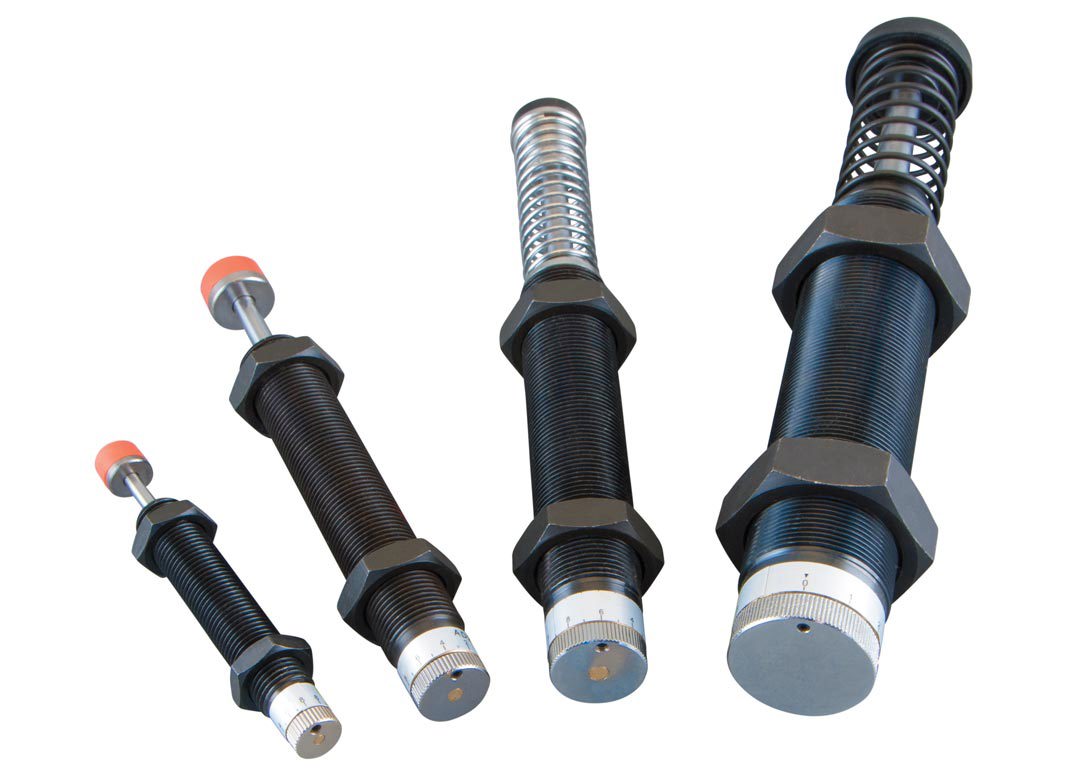

The drive for ever greater productivity means machine speeds tend to increase over time, but this can lead to increased vibration, wear and tear. WDS Components Parts Ltd offers a range of hydraulic shock absorbers that control deceleration of moving parts and conveyed items to prevent damage to machinery and products. Adrian Wells, product manager, at WDS explains how shock absorber technology varies and offers specification advice.
Industrial shock absorbers are designed to kinetic energy momentum, bringing moving objects to a controlled stop, or to change their direction. As such they are ideal for helping smooth product handling on conveyors and in chutes; for cushioning the movements of gates, guides and other machine parts; for enabling precision movement of positioning tables etc. They come in a range of sizes and capacities: at the small end they can be found in electronics production machinery with sizes increasing to manage all sorts of manufacturing, assembly and materials handling applications. They can also be used to cushion heavyweight doors and machine parts and are commonly used with pneumatically operated equipment to counteract the effects of sudden stops from high speed.
Hydraulic shock absorbers work by using a piston to expel oil from a chamber through an orifice; there are two main types, adjustable and self-compensating. Adjustable shock absorbers have a single variable orifice connected to an adjuster wheel which is used to partially close off the orifice and thereby match oil flow or load absorption capacity to given application requirements.
Self-compensating shock absorbers are based on a double tube mechanism in which oil is forced through a series of small orifices as the piston moves. The spacing and design of the orifices maintains a constant pressure on the piston throughout the full stroke, leading to a near-linear deceleration.
Use of shock absorbers mean machine speeds can be raised while maintaining smooth operation. The controlled deceleration of moving parts reduces wear on the machinery, damage to products, lowers noise and cuts vibration. This in turn reduces maintenance while extending machine life and bringing benefits to operator health and safety and the wider working environment.
Hydraulic shock absorbers represent the very best of stopping technologies because they can be matched to application needs and provide highly controlled deceleration. WDS also supplies other stopping solutions, such as simple low cost spring and rubber stops which may suit some applications where positioning and total energy dissipation are not required.
WDS hydraulic shock absorbers are easy to install, maintenance-free and typically last for the lifetime of the equipment upon which they are installed. The adjustable shock absorbers are made to a robust steel design with rubber cushion caps and can work in a temperature range from -10°C to 85°C.There are stroke options from 16mm to 50mm and their operating speed ranges from 3.2m/s to 3.6m/s. They have a maximum effective mass of 120kg to 1400kg depending on the size of the unit selected, which leads to a maximum energy capacity per cycle of 22Nm to 150Nm.
WDS’s self-compensating shock absorbers share the robust characteristics of the adjustable type and the operating temperature range. Size options M8 to M25 and stroke lengths from 8mm to 50mm are offered, most with a rubber cushion cap. Each body/stroke combination is offered with three speed capacities and the range accommodates maximum effective masses 2kg to 1200kg.

Having spent a decade in the fastener industry experiencing every facet – from steel mills, fastener manufacturers, wholesalers, distributors, as well as machinery builders and plating + coating companies, Claire has developed an in-depth knowledge of all things fasteners.
Alongside visiting numerous companies, exhibitions and conferences around the world, Claire has also interviewed high profile figures – focusing on key topics impacting the sector and making sure readers stay up to date with the latest developments within the industry.





